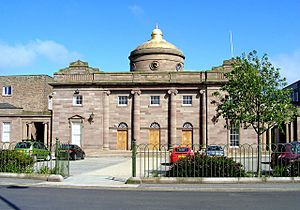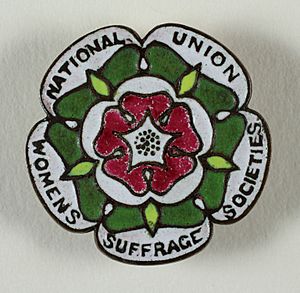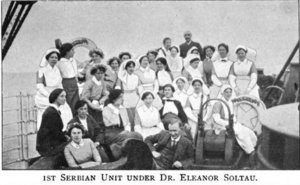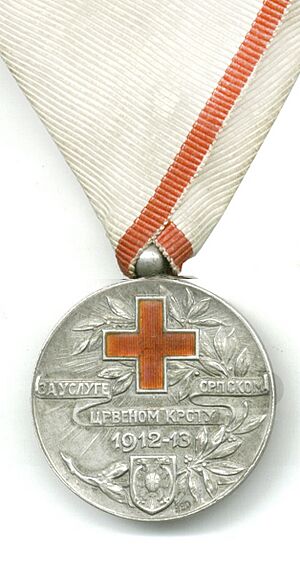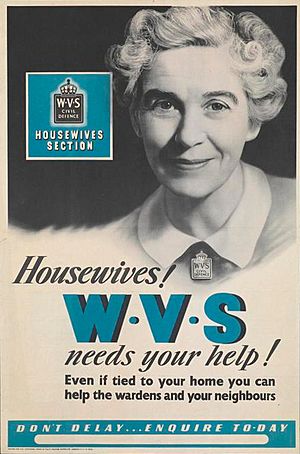Muriel Craigie facts for kids
Quick facts for kids
Muriel Craigie
|
|
|---|---|
| Born |
Catherine Muriel Craigie
1889 |
| Died | 9 December 1971 Stracathro Hospital
|
| Other names | C. Muriel Craigie |
| Education | Montrose Academy |
| Organization | Women's Army Auxiliary Corps Scottish Women's Hospitals for Foreign Service Townswomen's Guild and Women's Voluntary Service for Civil Defence |
| Known for | leadership in Women's Army Auxiliary Corps.,
Scottish Women's Hospitals for Foreign Service Townswomen's Guild, Women's Voluntary Service and supporting women's suffrage and better education |
| Awards | OBE 1919, Serbian Red Cross Medal |
Muriel Craigie, OBE (1889 – 1971) was an important Scottish woman who worked hard to help others. She was a strong supporter of women's right to vote. She was also a key organiser during both World War I and World War II, helping out as a volunteer. People also knew her as a "noted educationist" because she worked to improve schools and learning.
During World War I, Muriel helped set up the first Serbian unit for the Scottish Women's Hospitals for Foreign Service. This group provided medical care in war zones. For her amazing work, she received the Serbian Red Cross medal. She also became the main person in Scotland for recruiting women into the Women's Army Auxiliary Corps. For this, she was awarded the OBE in 1919.
In World War II, Muriel led the Women's Voluntary Services (WVS) in Montrose, Scotland. She helped organise comfort items for soldiers and arranged for children and vulnerable people to be moved safely away from dangerous cities. She was the only woman on the special 7-person Invasion Committee.
Muriel also played a big role in the Townswomen's Guild, a group for women. She was the national vice-president from 1951 to 1954. In total, she spent 25 years helping the Guild, from starting the local branch to leading the whole North East Scotland group. She was also the first woman to lead an education sub-committee in Angus county. She worked on education policy for twenty years, helping to make schools better.
Contents
Early Life and Education
Muriel Craigie was born Catherine Muriel Craigie in 1889. Her father, William Craigie, was the town's firemaster. She lived with her sister, Rhoda, at 5 Erskine Street in Montrose. Her father had been the firemaster for 37 years when he passed away in 1936.
Muriel went to Montrose Academy. She was a very good student, winning prizes in history, English, sewing, and physical drill. Later in life, she became the first woman to lead the Academy's prize-giving ceremony. She also enjoyed sports, winning a golf medal and playing for the Academy Girls' hockey team. She studied scripture at the St. George's United Free Church.
As an adult, Muriel continued to live with her sister. She was very active in her community. She took on leadership roles during both World Wars and supported women's right to vote. She also helped soldiers and children, and worked on county education committees. She also had important national roles in the Townswomen's Guild. She passed away at Stracathro Hospital on 9 December 1971, at the age of 82.
Fighting for Women's Vote
By 1913, Muriel Craigie was a key figure in the National Union of Women's Suffrage Societies (NUWSS). This group worked peacefully to get women the right to vote. She led meetings and gave speeches across the country. For example, she spoke to the Women's Cooperative Guild in Dundee.
Muriel also helped organise a special "Franchise Fortnight" tour. During this tour, important suffrage leaders spoke in many towns in Fife. They talked to different groups of people, from farmers at busy markets to factory workers. The newspapers reported on their efforts, noting that the NUWSS was a peaceful group. Muriel and the other speakers explained why women, who paid taxes, should have a say in how the country was run. They also talked about social problems that women's voices could help solve. Many audiences voted to support their call for women's voting rights.
In October 1913, Muriel toured West Lothian, speaking in seven towns. She explained that women were still denied the vote, even though working men had gained it. She argued that women also paid taxes and should have the right to vote for the people who decided on these taxes. Her arguments convinced many men to support women's suffrage. She also helped sell many copies of the NUWSS newspaper, The Common Cause.
World War I Efforts
When World War I began, Muriel Craigie quickly got involved. She used her connections from the NUWSS to join Dr Elsie Inglis's Scottish Women's Hospitals for Foreign Service (SWH). Muriel became an organiser for the SWH's first unit sent to Serbia. This unit was an all-women medical and nursing team. They went to the war zone to help the Serbian government.
When Dr. Inglis returned to Edinburgh in 1916, Muriel was there to welcome her. She presented Dr. Inglis with a bouquet of flowers. Muriel worked as the Press and Appeals Secretary at the SWH headquarters. For her dedicated service, she received the Serbian Red Cross medal from the Crown Prince of Serbia.
Muriel also organised events to raise awareness and funds. For example, she arranged for schools across Scotland to mark "Kossovo Day" in June 1916. This day aimed to teach about Serbia's history and support the allied nations. Any donations collected went to the SWH to help with their work in Serbia.
Leading the Women's Army Auxiliary Corps
By September 1917, Muriel Craigie became the main person in Scotland for recruiting women into the Women's Army Auxiliary Corps (WAAC). She encouraged women to join as cooks and domestic workers, explaining that the pay was good. For her important work with the WAAC, she was awarded an OBE.
Community and Guild Leadership
After World War I, Muriel used her great organisational skills in politics. She became the Scottish women's organiser for the Liberal Party. She also gave talks on political matters and other topics, like the poet Robert Burns.
Townswomen's Guild Leader
Muriel Craigie was a very active member of the Townswomen's Guild (TWG) for 25 years. She helped start the Montrose branch and represented her town at regional and national meetings. She became the national vice-chairman of the British National Union of Townswomen's Guilds from 1951 to 1954. When she officially retired, she was made the first honorary president of the North of Scotland Federation of Townswomen's Guilds.
By 1935, the Montrose branch of the TWG had grown to over 250 members. Muriel helped organise a large arts exhibition, showing off members' embroidery and crafts. She was elected president of the Montrose Guild in December 1936. In 1937, she led an event about the progress of the Elsie Inglis Memorial Hospital, which honoured the medical pioneer.
Muriel explained that the Guilds offered a wide range of activities, from creative crafts to public affairs and education. She noted that the TWGs had received grants and worked closely with education authorities. She also launched a competition for handiwork among the guilds. In 1939, she attended a national council meeting with 1,000 attendees, discussing the future of the 54,000-member national women's organisation.
She stepped down from leading the TWG in 1941 due to other duties. However, she returned for the Guild's seventh anniversary in 1942 to give a speech at their Burns supper. She also gave a lecture on the functions of the Education Committee in 1944. After the war, Muriel became President of the North-East Federation of the Townswomen's Guild. In 1953, she was elected national vice-chairman of the British National Union of Townswomen's Guilds.
In 1958, Muriel Craigie was elected as the first honorary president of the North of Scotland Federation of Townswomen's Guilds.
Education Committee Work
In 1937, Muriel Craigie became a member of the Montrose School management committee. She represented the county Education Committee. They discussed important topics like providing free school meals and feeding poor children during holidays.
She also joined the county sub-committee on religious instruction in 1937. She was responsible for schools in Montrose, Hillside, and Dun. Although some people thought she would be an "ideal member" for the Montrose local election, she chose not to run.
In 1938, she became the first woman to lead the prize-giving ceremony at Montrose Academy. After World War II, Muriel rejoined the county education committee. Later in her life, she became the first woman to lead the education sub-committee for the Montrose area.
Muriel was also part of the "keep fit" committee. This committee helped towns provide training leaders or grants for sports facilities like playing fields and public baths. She suggested surveying what was needed locally. In 1938, she opened the new filtration plant at the Montrose North Links School swimming bath. She also became the leader of the North Links School sub-committee and helped lead the Poor Children's Clothing Fund.
World War II Responsibilities
In 1939, Muriel Craigie became the local co-ordinator for the Women's Voluntary Services (WVS) for Civil Defence in Montrose. This was a huge job. It involved organising volunteers and making sure that evacuees (children, teachers, and vulnerable adults) were safe. These people were moved from industrial cities, which were likely targets, to smaller, safer towns.
The WVS surveyed homes to find suitable places for evacuees to stay. They also made sure the children had clothes. Muriel and her Townswomen's Guild teams organised the making or donation of 1,000 first aid supplies for the Forfar hospital. Muriel also served on the Montrose Red Cross committee from the start of the war.
Supporting Troops and the Home Front
In 1940, Muriel coordinated the WVS depot that collected comfort items for the troops. She brought together local churches and seventeen women's groups. In the first month, they collected over 400 items. The Black Watch Fund helped pay for wool and distributed the finished items. An appeal was made for money, as millions of men were expected to join the armed forces.
In her first WVS report, Muriel said that 600 items had been sent to the British Expeditionary Force, along with sweets and three footballs for Christmas. By June 1940, over 1,300 items had been donated from her Montrose War Comforts Depot.
In her next annual report, Muriel shared that a new Mending Depot handled almost 18,000 bundles of laundry. WVS volunteers also ran Rest Centres for air raid victims and helped write out 6,000 Ration cards. They sent out over 1,100 comfort items, including garments and slippers. A Housewives Service started in 1940-41 to teach women at home about fire-fighting, first aid, and using gas masks. Muriel thanked all the volunteers, shopkeepers, and businesses for their support.
Lady Balfour and the Countess of Dalhousie visited Montrose and praised Muriel and her teams. In September 1942, Muriel began giving lectures on the WVS's role in civil defence and basic training. She also suggested using a "broadcasting van" to give cooking demonstrations in the streets. This idea was taken up by the Council to encourage local classes on cooking and saving fuel.
Serving on the Invasion Committee
In 1942, Britain prepared for a possible Nazi invasion. Muriel Craigie was the only woman on the seven-person Montrose Invasion Committee. She represented the WVS alongside senior members of the Home Guard, police, fire service, and council.
Winding Down Wartime Services
After six years, the county WVS services began to close. Muriel reported that volunteers were still helping evacuees with coal, furniture, blankets, and clothes even up to VE-Day. They also sent 2 tons of goods and money to help people re-home after bombings in Stepney. Knitted goods continued to go to naval and merchant navy personnel or European relief projects after the war ended.
Muriel praised the "untiring and devoted services" of her co-ordinating committee, calling them "the faithful twenty-five." She also thanked the public authorities for their help. At a celebration for the "Stand Down of the Montrose W.V.S.," Muriel reviewed the work done. She noted that knitters would continue their work over the next winter. She praised the volunteers' "spirit of co-operation" and "splendid and loyal help." Her group also received a thank you letter from the Earl of Airlie.
In 1946, Muriel was given a cheque to recognise her service as the Montrose WVS centre leader. She continued to serve on the Angus county council food control committee into the 1950s.
First Woman to Lead Education Sub-Committee
In 1949, Muriel Craigie was voted onto the Angus county council Education Committee again. She gave a talk about its work to the Montrose Business and Professional Women's Club. She discussed the new Education Act, which covered education for 3 to 18-year-olds, as well as adult education. She explained that this would impact local taxes but also bring many benefits. Her talk covered nursery education, school transport, different types of senior schools, and the school meals service.
She noted that education spending had increased significantly. In 1953, she was elected as the only woman on the education group. She became the first female leader of the education sub-committee for the district of Montrose. When re-elected in 1955, she promised to keep their meetings "short and business like."
Muriel became the chairman of the Angus further education committee. She spoke at a prize-giving for young apprentices in building trades. She said that in the competitive "new world," the country would need "thousands of highly-skilled technicians." She explained that the courses could lead to a City & Guilds certificate, which was useful worldwide. The next speaker agreed, linking hard work to confidence and responsibility. Muriel was praised for her useful work chairing two county education sub-committees.
When she retired from the committees after twenty years, Muriel Craigie was called a "noted educationist" and a "most efficient chairman." People said that the town and county owed her a lot for her "ungrudging public service."
Honours and Awards
- Serbian Red Cross Medal
- Member of the Order of the British Empire (OBE)


